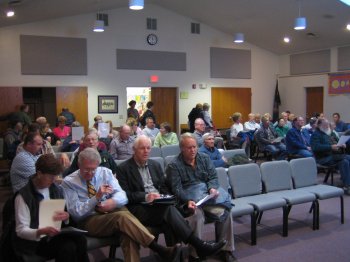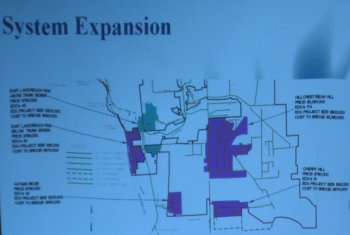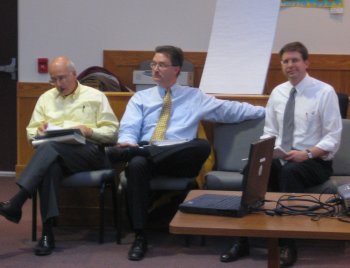- By Dan Veaner
- News
 Print
Print
Wednesday's sewer information meeting drew a crowd almost large enough to fill the Town Hall. And the ones who spoke weren't happy about the prospect of a Lansing sewer. The purpose of the meeting was to give as many interested residents as possible information about the project, including its scope, benefits and costs, as well as to give the public to ask questions or raise concerns.

Some came to get clarifications or to ask questions about one aspect of the project or another. Others were openly hostile, accusing the Town Board of trying to sneak the project through, or benefiting out of town developers at the expense of residents. "They bring it up every six months until they shove it down the taxpayers' throats," said one man in a heated statement.
Board members pointed out that they have not yet made a decision on whether to form the sewer district, and that if they do the public will have an opportunity to vote on the project. At that, some residents were not happy with the fact that they would have to initiate a petition, rather than the Town initiating a vote. But Supervisor Steve Farkas noted that even that hasn't been decided yet, and that it will be decided in a public meeting. Town Attorney Guy Krogh explained the options the board has in creating the sewer district and how that would affect who initiates a vote, and who would be eligible to vote.
The meeting began with a presentation by Stearns & Wheler engineer James Blum and Town engineer David Herrick, who presented an updated Powerpoint presentation that explained the $18 million project and sought to answer some questions raised in earlier meetings. In past meetings residents had raised questions about homes within the district that are not included in the initial service area. The engineers showed maps that laid out where the future collection system will be.

Map shows neighborhoods including two sections of
East Lake/Reach Run, Autumn Ridge, Hillcrest/Bean Hill,
and Cherry Hill, and what it will cost to include them
in the sewer service area
One map broke out some neighborhoods, showing what it would cost to add them to the service area. Engineers explained that the initial service area included neighborhoods that require sewer for environmental reasons, such as faulty septic systems on the lakefront, or because it is cost effective to bring sewer to a particular neighborhood. The map laid out six neighborhoods with differing circumstances. For example one neighborhood that could tie into the system by gravity was less than another that would have to pump effluent up to reach the collection system.
Blum listed the differences in cost to bring each neighborhood on line, and said that funds would have to be found to help residents pay that cost difference. He also explained the difficulty the committee had in determining who would pay for what. "The sewer committee went back and forth looking at different options," he said. "The reason it is difficult is because in order to put in a foot of pipe it's a set cost. What's difficult to say is who is paying to put in that foot of pipe. How are the costs associated with that foot of pipe distributed?"
Herrick noted that the County Health department is currently putting together data that will show how much of a problem existing septic systems are, in terms of the failure rate of septics and the number of 'compromised systems,' which are those that do not meet current standards but can not be brought into compliance because there is not enough room on a plot of land to handle the requirement, or some other reason. He said that systems in possible problem neighborhoods such as Ladoga Park are currently being tested and that a planned fly-over with infrared equipment that will show septic system leaks will provide
Hugh Bahar, who recently launched nolansingsewers.com, challenged this data, saying that only a full environmental impact study is scientific. "There may be some (faulty septic systems) on the lake, and that is an issue," he said. "But they probably should be resolved by the property owners, and not by the Town of Lansing." He also said that the Cayuga Heights plant has problems, especially when it rains, and made numerous other arguments against the project.
George Gesslein, representing the 41 seniors who live at Woodsedge, urged the Board to reconsider how costs are being allocated. "There's no comparison between a senior in a one bedroom apartment and somebody in a 4,000 square foot house," he said. He asked the Board to pursue more grants, but was said he favors the sewer. "I think that the Town needs it for future development. Sooner or later it's going to happen, and the sooner it happens the lower the cost."
James and Mary Sullivan spoke against the project, noting that the hookup cost would be onerous for them because they would have to pump up from their house to the collection system on East Shore Drive. James noted that one of the justifications of the project is to provide a framework for sensible development in Lansing. "I don't want to finance development," he said. "Please don't shove this down my throat."

(left to right) Sewer Committee member Andy Sciarabba, Engineers
David Herrick and Jim Blum
Sewer Committee member Andy Sciarabba tried to answer some of the questions residents raised, and why he thinks sensible development is better than haphazard development. "It's important for this community to have sewer, because we're growing anyway," he said. He noted that he doesn't consider the 'worst case' cost of $854 acceptable. Claus Nyberg asked Sciarabba what he considers an acceptable cost. "You tell me," Sciarabba replied. "Everybody has their own opinion. My goal is to get it down to the $550 range. That's my personal opinion. That's why I'm working my butt off to try to raise donations. I want to get it down."
Others complained that they would not be able to afford to stay in Lansing in their retirement, or could lose their homes or businesses. Concerns were raised about the accuracy of the cost estimates, environmental concerns, and whether the regional approach reflected in the plan is more expensive that a stand-alone plan. Engineers said they are working with Tony Nekut, who raised this concern, "to make sure we are comparing apples to apples." Nekut noted that it is unfortunate that the DEC won't let the Town use more than $5 million in grant funding for a stand-alone plant.
While it was clear that many of those present were against the project, some went farther to challenge the Board's motives, accusing them of not communicating public meeting times and of trying to sneak the project into existance without informing residents. Officials took exception to that view, saying that meetings are announced, posted on the sign in front of the Town Hall, on the Town Web site, and that anyone can call the Town Hall for the information. Farkas and others noted that no decision has been made yet, and that the only official action they have taken so far has been to accept the draft engineer's report that describes the project. He said the decisions will be made in public meetings.
Farkas announced that a second 'open house' is planned for Saturday, December 9 from 10am to 1pm when residents are invited to speak to Town officials, committee members and engineers one on one to express concerns and have questions answered.
----
v2i41

Some came to get clarifications or to ask questions about one aspect of the project or another. Others were openly hostile, accusing the Town Board of trying to sneak the project through, or benefiting out of town developers at the expense of residents. "They bring it up every six months until they shove it down the taxpayers' throats," said one man in a heated statement.
Board members pointed out that they have not yet made a decision on whether to form the sewer district, and that if they do the public will have an opportunity to vote on the project. At that, some residents were not happy with the fact that they would have to initiate a petition, rather than the Town initiating a vote. But Supervisor Steve Farkas noted that even that hasn't been decided yet, and that it will be decided in a public meeting. Town Attorney Guy Krogh explained the options the board has in creating the sewer district and how that would affect who initiates a vote, and who would be eligible to vote.
The meeting began with a presentation by Stearns & Wheler engineer James Blum and Town engineer David Herrick, who presented an updated Powerpoint presentation that explained the $18 million project and sought to answer some questions raised in earlier meetings. In past meetings residents had raised questions about homes within the district that are not included in the initial service area. The engineers showed maps that laid out where the future collection system will be.

Map shows neighborhoods including two sections of
East Lake/Reach Run, Autumn Ridge, Hillcrest/Bean Hill,
and Cherry Hill, and what it will cost to include them
in the sewer service area
One map broke out some neighborhoods, showing what it would cost to add them to the service area. Engineers explained that the initial service area included neighborhoods that require sewer for environmental reasons, such as faulty septic systems on the lakefront, or because it is cost effective to bring sewer to a particular neighborhood. The map laid out six neighborhoods with differing circumstances. For example one neighborhood that could tie into the system by gravity was less than another that would have to pump effluent up to reach the collection system.
Blum listed the differences in cost to bring each neighborhood on line, and said that funds would have to be found to help residents pay that cost difference. He also explained the difficulty the committee had in determining who would pay for what. "The sewer committee went back and forth looking at different options," he said. "The reason it is difficult is because in order to put in a foot of pipe it's a set cost. What's difficult to say is who is paying to put in that foot of pipe. How are the costs associated with that foot of pipe distributed?"
Herrick noted that the County Health department is currently putting together data that will show how much of a problem existing septic systems are, in terms of the failure rate of septics and the number of 'compromised systems,' which are those that do not meet current standards but can not be brought into compliance because there is not enough room on a plot of land to handle the requirement, or some other reason. He said that systems in possible problem neighborhoods such as Ladoga Park are currently being tested and that a planned fly-over with infrared equipment that will show septic system leaks will provide
Hugh Bahar, who recently launched nolansingsewers.com, challenged this data, saying that only a full environmental impact study is scientific. "There may be some (faulty septic systems) on the lake, and that is an issue," he said. "But they probably should be resolved by the property owners, and not by the Town of Lansing." He also said that the Cayuga Heights plant has problems, especially when it rains, and made numerous other arguments against the project.
George Gesslein, representing the 41 seniors who live at Woodsedge, urged the Board to reconsider how costs are being allocated. "There's no comparison between a senior in a one bedroom apartment and somebody in a 4,000 square foot house," he said. He asked the Board to pursue more grants, but was said he favors the sewer. "I think that the Town needs it for future development. Sooner or later it's going to happen, and the sooner it happens the lower the cost."
James and Mary Sullivan spoke against the project, noting that the hookup cost would be onerous for them because they would have to pump up from their house to the collection system on East Shore Drive. James noted that one of the justifications of the project is to provide a framework for sensible development in Lansing. "I don't want to finance development," he said. "Please don't shove this down my throat."

(left to right) Sewer Committee member Andy Sciarabba, Engineers
David Herrick and Jim Blum
Sewer Committee member Andy Sciarabba tried to answer some of the questions residents raised, and why he thinks sensible development is better than haphazard development. "It's important for this community to have sewer, because we're growing anyway," he said. He noted that he doesn't consider the 'worst case' cost of $854 acceptable. Claus Nyberg asked Sciarabba what he considers an acceptable cost. "You tell me," Sciarabba replied. "Everybody has their own opinion. My goal is to get it down to the $550 range. That's my personal opinion. That's why I'm working my butt off to try to raise donations. I want to get it down."
Others complained that they would not be able to afford to stay in Lansing in their retirement, or could lose their homes or businesses. Concerns were raised about the accuracy of the cost estimates, environmental concerns, and whether the regional approach reflected in the plan is more expensive that a stand-alone plan. Engineers said they are working with Tony Nekut, who raised this concern, "to make sure we are comparing apples to apples." Nekut noted that it is unfortunate that the DEC won't let the Town use more than $5 million in grant funding for a stand-alone plant.
While it was clear that many of those present were against the project, some went farther to challenge the Board's motives, accusing them of not communicating public meeting times and of trying to sneak the project into existance without informing residents. Officials took exception to that view, saying that meetings are announced, posted on the sign in front of the Town Hall, on the Town Web site, and that anyone can call the Town Hall for the information. Farkas and others noted that no decision has been made yet, and that the only official action they have taken so far has been to accept the draft engineer's report that describes the project. He said the decisions will be made in public meetings.
Farkas announced that a second 'open house' is planned for Saturday, December 9 from 10am to 1pm when residents are invited to speak to Town officials, committee members and engineers one on one to express concerns and have questions answered.
----
v2i41



